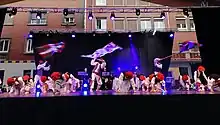Salleko Dance Group
The Salleko Dance Group (in Basque, Salleko Dantza Taldea; in Spanish, Grupo de Danzas Salleko) is a Basque cultural association founded in 1962, whose objective is the institutionalization and promotion of Basque dance, a relevant aspect of Basque culture.[1][2]
.jpg.webp) | |
| Established | 1962 |
|---|---|
| Purpose | institutionalization and promotion of Basque dance |
| Location |
|
Official language | Spanish, Basque |
History
Establishment
The Basque dance and music group was founded in 1962 by Brother Basilio, of the De La Salle Brothers, as a school group.[3][4] The Salleko Basque dance group directed its work from the beginning of research, learning, teaching and dissemination of Basque dance and Basque folklore.[5][6]
1970s - 2000
One of the main members of the group was Fernando Irasuegui, a txistu teacher and member of the Sestao Municipal Music Band.[4] In its beginnings, during the 1970s and 1980s, the dance group had to make a selection of dancers (dantzaris), because many people wanted to be part of the group.[7]
Due to its growth, in 1988 it was legally constituted as a cultural association to institutionalize itself as a cultural organization and continue with the work it had carried out up to that moment. Since its creation, the dance group has performed in almost every municipality and every province throughout Spain.[8][9][10] In addition, they have also performed in other countries such as France or Italy.
The name "Salleko" means "of La Salle" in Basque (Salle-ko). The name comes from the creation of the group by Brother Basilio at the La Salle Brothers College in Sestao, group of "la Salle", Salleko.
2000 - present

The group is based in a facility ceded by the private Catholic school Colegio Begoñako Andra Mari-La Salle in the municipality of Sestao (a school that emerged in 2001 from the merger of the contiguous schools Colegio Hermanos de La Salle, for boys, and Colegio Hijas de la Cruz, for girls).
The dance group is formed in Basque dances and in the different provincial modalities of Basque dances (zazpi jauzi, arin-arin, aurresku,...).[11] In addition, the Salleko dance group organizes annual events such as the Folklore Show, the Umeen Euskal Jaia, dance workshops, pilgrimages and others.[12] Within the annual organization of the Folklore Show, groups from all over the world are also invited to Spain.[13] He has also participated in the Dantzari Eguna (day of the dancer, in Basque) since its inception,[14] or in the Bizkaiko Dantzari Eguna, which Salleko hosted in 1989 and in 2019.[15][16]
In 2012, the Salleko dance group celebrated its 50th anniversary with various events in Sestao and also some events at the Barakaldo Theatre.[17] For the 50th anniversary, former dancers (dantzaris) also met to whom a tribute was paid.
See also
References
- Pérez, Un reportaje de J. (2022-11-25). "Salleko Dantza Taldea, seis décadas de danzas en las plazas" [Salleko Dance Group, six decades of dances in the squares]. Deia (in Spanish). Retrieved 2023-03-19.
- "El grupo de danzas Salleko de Sestao celebra su 50 aniversario en el Teatro Barakaldo" [The Salleko Dance Group, from Sestao, celebrates its 50th anniversary at the Barakaldo Theatre]. Retrieved 2023-03-19.
- enSestao.com (2022-02-08). ""El Salleko fue una de las primeras asociaciones de Sestao y eso deja huella"" ["Salleko was one of Sestao's first associations and that leaves its mark"]. enSestao.com (in Spanish). Retrieved 2023-03-19.
- Zunzunegi, E. (2012-05-04). "Salleko danza en Sestao" [Salleko dances in Sestao]. Deia (in Spanish). Retrieved 2023-03-19.
- "El grupo Salleko de Sestao bailará al fuego en San Pedro | Dantzanet". www.dantzanet.net. Retrieved 2023-03-19.
- "Sestao, capital de las danzas vizcainas | Dantzanet". www.dantzanet.net. Retrieved 2023-03-19.
- dantzancom. "Raimundo Flores, la búsqueda de la perfección en el vestuario". dantzan.eus (in Basque). Retrieved 2023-03-19.
- 20minutos (2012-08-31). "El festival Concejo Folk de Palencia llega hoy a su fin con la actuación de tres grupos de danzas". www.20minutos.es - Últimas Noticias (in Spanish). Retrieved 2023-03-19.
- "Espectacular Festival Folclórico de Torremolinos 'Juan Navarro'". vivapunta.es (in Spanish). Retrieved 2023-03-19.
- "Government of Galicia. 2012. Salleko" (PDF).
- "Las danzas de Navarra llegan a Sestao, de la mano del Grupo de Danzas Salleko" [The dances of Navarra arrive in Sestao, thanks to the Salleko Dance Group]. www.dantzanet.net. Retrieved 2023-03-19.
- "Sestaoko Folklore Erakusketa | Dantzanet". www.dantzanet.net. Retrieved 2023-03-19.
- enSestao.com (2018-07-06). "Celebrada la XXXII Muestra de Folklore impulsada por el Grupo de Danzas Salleko". enSestao.com (in Spanish). Retrieved 2023-03-19.
- Armentia, Iñaki (2015-11-30). "Así fue el Dantzari Eguna de Vitoria en 1972: vídeo y fotos". Cadena SER (in Spanish). Retrieved 2023-03-19.
- "La danza sale al campo | Bizkaiko dantzari eguna". www.dantzarieguna.net. Retrieved 2023-03-19.
- Zunzunegi, Emilio (2019-01-08). "Sestao acogerá 30 años después una nueva cita del Dantzari Eguna". Deia (in Spanish). Retrieved 2023-03-19.
- "Salleko Sestao | Grupo de danzas Salleko | 50 aniversario | Sestao" (in European Spanish). 2012-05-03. Retrieved 2023-03-19.